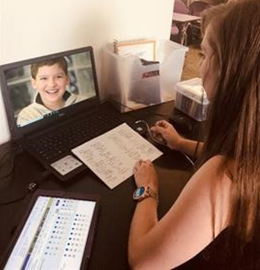Schools are closed. You’re working from home AND trying to supervise your child’s learning. You are not a teacher, you have no desire to be a teacher, you enjoy letting someone else be your child’s teacher, and now you are about to lose your mind. This is not what you signed up for when you became a parent. In the middle of a pandemic, most parents are in a similar boat. So, here are 5 tips to take some of the pressure off. As an educational and cognitive psychologist, child development specialist, and a former teacher of teachers, here’s my expert advice to help you maintain your sanity while your kids are learning at home:
1. Stop Hovering

No need for helicoptering. There is a huge difference between homeschooling and attending school from home. Your child’s teacher is still his/her primary educator. Your role is to provide a comfortable environment, any needed supplies, and assistance. It’s a support role. Let’s face it, you have your own responsibilities.
Whether you’re working remotely, taking care of younger children, figuring out creative meals with limited access to ingredients, or trying to continue managing your regular household routines (laundry, dishes, housekeeping), you have a life outside of monitoring your child’s remote learning. LIVE THAT LIFE. Do your best to maintain as many of your regular routines as you can. Offer guidance to your child as needed. Ask for assistance from your child’s teacher if necessary. Relax your expectations. A month or two of reduced academic rigor will not destroy your child’s educational journey. And enjoy the added facetime you have with your family right now. It’s a good time to just love each other.
2. Let Your Child Choose His Own Learning Space
(click for my video clip of this tip!)

While many experts are touting the importance of setting up a structured learning environment for your child at home, I’m saying, “Wait a minute. Not so fast.” The research on alternative seating in classrooms is undeniably positive. So, as parents, we need to get it out of our heads that the “desks in rows” classroom arrangement that we grew up with is what we need to approximate in our homes right now.
Instead, shift your paradigm. Let your child choose a comfortable place to learn. Soft seating is easier on his growing body than a hard chair. And, the freedom to choose where to sit is empowering, motivating, and a surefire way to increase his engagement in the learning task. My 15-year old came flying down the stairs the first day of at-home learning telling all of us how much he enjoyed his math class in bed. If my high schooler says he enjoyed math class, do I really care where he was sitting? Let him love math! So, let your child choose. A soft chair in the living room, a recliner in the basement, a cushioned window seat above the garage, a bed, or the sunroom sofa can all provide a personal and comfortable learning space. It’s okay. Really.
3. Don’t Micromanage Your Child’s Schedule
If your child has “live” lessons to attend, then it’s important to ensure he is present during those class times. Absolutely provide her with assistance logging in on time if needed. Everything else? Forget the clock. It’s just too stressful for you to worry about your child’s productivity all day while maintaining your own. Instead, spend 10 minutes each morning helping your child plan his day. Help her create a to-do list of assignments, tasks that need to be completed, recorded lessons to watch, and any other school requirements. Then, set a deadline. For example, school tasks need to be completed by 3pm or 6pm or even 9pm—whatever works best for your family. Then, give your child the freedom to read, eat, play a video game, or chat with friends throughout the day to ensure they have learning breaks and stay socially connected. At the end of the day, review the to-do list with your child and provide guidance as needed. This is a great way to teach self-regulation and responsibility. You may have to make adjustments based on your child’s age and maturity level—some children can handle more wiggle room in their schedules than others. And a lunchtime check-in might also be needed for some. But, overall, the chance to help determine one’s own schedule is empowering, motivating, and can increase engagement! (Sound familiar?) And it takes pressure off you to micromanage your child’s day. It’s just not necessary. Really.
4. Connect with Your Child

As scary and uncertain as we feel right now, this can be an even scarier time for children. Their world has been turned upside down, too. So, keep their need to be reassured in mind when they interrupt you during the day. Plan for those interruptions. It may mean that you have to finish your work after they go to bed.
Or that you get up an hour early each day to get some work in before your child is up. Plan for that. If you start each day anticipating interruptions, those interruptions will seem less irritating when they happen. Your child’s emotional health is more important than any work—yours or his—during this time. So, connect with him. Reassure her. Smile when your child speaks to you. Look up from your computer screen, make eye contact, speak gently, and connect. You can set boundaries. Times when they need to wait to talk to you. (Like during Zoom meetings!) But, put a sign up or pass them a note saying when you will be free. I use a sticky note with the exact time such as, “I’m in a meeting. Come back at 1:15.” Add a smiley face or a heart. Connect. Really.
5. Ask for Help if Your Child is Struggling

Some children struggle to learn, regardless of the location. This may be the first time you are seeing your child struggle. It can be overwhelming, disconcerting, frustrating, and emotional when you realize your child is having a hard time with school. The good news? There are many resources available. You just need to ask for help.
The first stop should be your child’s teacher. Find out what struggles she has noticed and how she has addressed them. If you have a child who is struggling with an advanced class like Calculus, the fix is easy. Find a tutor. There are lots of online tutoring options. But, if your child is struggling in more than one class, she may have an underlying problem that needs to be addressed. Many learning struggles are caused by weak cognitive skills like memory, attention, and speed of information processing. A brain trainer can help strengthen those skills to make learning easier. Consider a consultation with LearningRx whose brain trainers can work with your child remotely via videoconferencing. Ultimately, there are many resources. Even though doors are closed right now, virtual technology allows helping professionals to continue helping!
Some final thoughts. You’re reading and listening to a ton of advice right now. From experts, from bloggers, from your Facebook friends. It can be overwhelming, I know. If you take away nothing else from my advice, take this when it comes to your child’s experience with at-home learning: Put love first. Everything else will be okay. Really.
From my brain to yours,
Dr. Amy
Amy Lawson Moore, PhD
Cognitive & Educational Psychologist
Note: This article was originally posted on ShesBrainy.com, Dr. Amy’s old blog.
